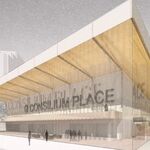Re: John Barber blasts "Toronto Unlimited" campaig
Please visit 'somehow majestic' Toronto
Royson James
Toronto Star
It's not often that Toronto gets to tell its story to the world. Good thing, too, judging by the two-page ad in last Sunday's New York Times.
One page features star architect and Toronto-born Frank Gehry. I'm cool with that.
The other page promises readers, "Toronto: an eclectic tour of an eclectic city." It delivers no such thing.
The 600-plus word essay is wordy, poorly written, riddled with inanity, conflicted and apologetic, negative where it should be positive, and is passive in voice and tone instead of "compelling and action-inspiring," as its authors intended.
Sentences roam aimlessly hinged by poor syntax, grammar and punctuation and, in parts, wholly incomprehensible.
Consider this, word for word, near the beginning, "And while all these answers are true. It is barely scratching the surface. Toronto is one of those rare instances where its true unique nature makes it difficult to describe without being clich?."
In short, the effort is sophomoric and weak.
Saddest of all, the bright minds at Tourism Toronto spent 13 months, did 4,500 surveys, conducted 230 in-depth interviews and held 14 focus groups in Canada, the U.S. and the U.K. and budgeted $4 million to deliver the flawed campaign.
Tell us, please, that this "rebranding" of Toronto is some sort of spoof. `Cause, if it's not, somebody ought to be hanged on Nathan Phillips Square.
In fact, Tourism Toronto's coming out party, complete with new logo, "Toronto Unlimited" brand name and multimillion-dollar advertising campaign, is proving an embarrassment.
The source of the angst? The ads, the very vehicle expected to deliver tourists to the newly branded city of imagination.
"I'm going to get into trouble for saying it, but this is lousy," said Councillor Brian Ashton yesterday after reading the Times ad for the first time.
"It reads like some sort of a apologetic flow of consciousness," Ashton said, falling into synch with the tenor of the ad.
"The city of Toronto, just a 90-minute flight from New York, is perhaps the most underrated city in North America," the essay begins.
A bit negative, sure. But not nearly as bad as what follows.
I can live with "Toronto Unlimited," the new obtuse tag line that goes with the new logo.
I can imagine how the logo, deliberately understated and underwhelming, might wheedle itself subliminally into the consciousness of unsuspecting tourists and lure them to the Little Apple or the T-dot.
I can even figure why it took so long and cost so much to produce a brand that many have ridiculed since its launch last week. After all, the $4 million cost includes the purchase of multi-page newspaper ads in New York, Chicago, Washington and the two-page local ads running here.
But for the life of me, I can make neither head nor tail of the essay, the words that are supposed to sing, to lure, to attract, to compel and finally convince tourists to flock to Toronto, the best undiscovered treasure city in North America.
Neither can Councillor Ashton, who led the political arm of the branding initiative as chair of the economic development and tourism committee. They signed off on the Toronto Unlimited tag and logo but have not seen the ads.
Tourism Toronto used to depend on city council for funding, but no longer needs property tax dollars. Most of its money now comes from a tax on visitors using GTA hotel rooms. Suddenly, an outfit that couldn't promote its product for want of cash is flush.
Consequently, Toronto cut its annual funding this year to $500,000 from $3 million. And with the cut, Tourism Toronto has sought more independence.
The ad campaign suggests it needs more oversight.
Some samples:
"Toronto is nearly indefinable, nearly infinite in its possibilities for the traveller, and nearly impossible to forget once you've been there. And perhaps what makes this place so original, so individual and somehow majestic is that it is a product of natural occurrences."
"It's supposed to be punchy, to the point. People don't have time. It should be big, bold, brash," Ashton said.
And how about this? "And how else to best explain it but to begin not with the impressive CN Tower or any major skyline player, but with those intersections, streets and districts whose mention conjures up completely original feelings in each of those who've traversed them."
The ad works as an essay to be dissected on an English exam. But as advertising copy, it reeks.
Mayor David Miller, the city's chief booster, was so put off by the ad he ducked all questions about it yesterday.
"It's Tourism Toronto that has to answer for the ad," said Miller's spokesman Patchen Barss.
Is the mayor proud of the ad?
"He's decided not to comment," Barss said sheepishly.
Do you think the ad represents the city well?
"We just want to say it's been reported erroneously that money from the city went into the ads. Not a penny did," Barss says, trying to change course.
We get the message.
Before they run the second ad next week and before they take the ads to Ontario towns, Rochester, Buffalo, London, England, and beyond, Tourism Toronto might want to do a rewrite.










